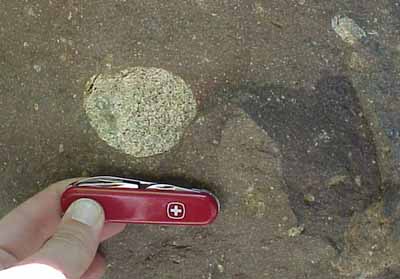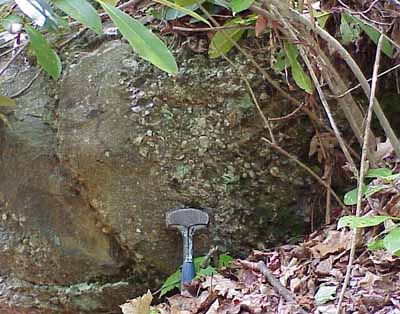|
|
||||||||
 Here we have a good look at the upper part of the Konnarock Formation. Mostly the rock is sandy with mud filling the spaces between the sand grains. However, embedded within the sand there are large cobbles of various rocks (some of which we have already seen today). You can see these in the photo to the left. The light cobble on the left is a piece of Cranberry Gneiss while the dark one on the right is a piece of Mt. Rogers rhyolite. The cobbles generally don't touch each other and the rock is quite unlayered and lack bedding planes. Such a chaotic unlayered rock is called a "diamictite". We have seen large cobbles in rocks before: as stream pebbles in the Mount Rogers Formation of stop 1, and as dropstones in the lower Konnarock in stop 3. But this rock is different from stops 1 and 3. How so? How could this have formed? Hint: glaciers are involved here. What evidence is there to tell us whether the glaciers were small local glaciers or large ice sheets? Answer Here we have a good look at the upper part of the Konnarock Formation. Mostly the rock is sandy with mud filling the spaces between the sand grains. However, embedded within the sand there are large cobbles of various rocks (some of which we have already seen today). You can see these in the photo to the left. The light cobble on the left is a piece of Cranberry Gneiss while the dark one on the right is a piece of Mt. Rogers rhyolite. The cobbles generally don't touch each other and the rock is quite unlayered and lack bedding planes. Such a chaotic unlayered rock is called a "diamictite". We have seen large cobbles in rocks before: as stream pebbles in the Mount Rogers Formation of stop 1, and as dropstones in the lower Konnarock in stop 3. But this rock is different from stops 1 and 3. How so? How could this have formed? Hint: glaciers are involved here. What evidence is there to tell us whether the glaciers were small local glaciers or large ice sheets? Answer
|
||||||||
 A good place to ponder these questions is to sit on the boulders that line the beautiful Green Cove Creek - a beautiful place to ponder anything. A good place to ponder these questions is to sit on the boulders that line the beautiful Green Cove Creek - a beautiful place to ponder anything. |
||||||||
|
|
||||||||
 Walk a short distance north from spot 9 and look closely at the outcrops on the right. Hey, wait a minute!! The rocks have done another big change. Note the trains of pebbles that form bands that run vertically up the outcrop, like in the photo to the left. How are they different from stop 9 both in terms of texture and composition? Walk a short distance north from spot 9 and look closely at the outcrops on the right. Hey, wait a minute!! The rocks have done another big change. Note the trains of pebbles that form bands that run vertically up the outcrop, like in the photo to the left. How are they different from stop 9 both in terms of texture and composition?
How must the environment of deposition have changed since stop 9? Spot 9 rocks are Proterozoic in age. These rocks are Cambrian in age. Thinking of the geologic time scale, what is the significance of that? Hmmmm........ Answer |
||||||||
|
|
||||||||
 This spot is a little hard to find at certain times of the year. Back behind the vegetation on the right side (as you walk north) there are weathered outcrops of a different rock. You can find the outcrop sometimes by looking for pieces of it like in the photo on the side of the road. It is heavy, dark, and fine grained. Don't throw this at anybody! What is it? Answer This spot is a little hard to find at certain times of the year. Back behind the vegetation on the right side (as you walk north) there are weathered outcrops of a different rock. You can find the outcrop sometimes by looking for pieces of it like in the photo on the side of the road. It is heavy, dark, and fine grained. Don't throw this at anybody! What is it? Answer
|
||||||||
|
|
||||||||
| Note the scattered outcrops between stops 11 and 13. The rock is still mostly a sandstone, but is undergoing a subtle but significant change in mineralogy. We will have a more thorough discussion at spot 13. No pictures here...so keep on travellin'!
|
||||||||
 |
||||||||